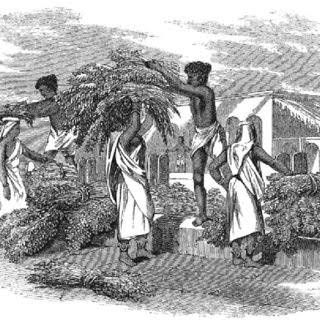सिंहासन हिल उठे राजवंशों ने भृकुटी तानी थी,
बूढ़े भारत में आई फिर से नयी जवानी थी,
गुमी हुई आज़ादी की कीमत सबने पहचानी थी,
दूर फिरंगी को करने की सबने मन में ठानी थी।
चमक उठी सन सत्तावन में, वह तलवार पुरानी थी,
बुंदेले हरबोलों के मुँह हमने सुनी कहानी थी,
खूब लड़ी मर्दानी वह तो झाँसी वाली रानी थी।।
– सुभद्रा कुमारी चौहान (भारतीय कवि)
Around 3000 rebellious Indian soldiers erupted with excessive outrage on 10 May 1857 against the oppressive colonial system in the garrison town of Merrut. Crossing Jamuna river, the revolutionaries entered Delhi, attacked British cavalry posts, police stations, killed European officials and ascertained their control over Red Fort and Salimgarh Fort. The upsurging rebellion gained the political support of Nana Saheb– the adopted son of late Peshwa Baji Rao, the queen of Jhansi Rani Laxmibai, Mughal Emperor Bahadur Shah Zafar, Tantia Tope, Rani Awantibai. Identifying with the ongoing mutiny, the general masses had also started to participate actively against the British regime. The magnified upheaval is gloriously remarked in Indian History as Revolt of 1857, Sepoy Mutiny and India’s First War of Independence. It was an aggressive expression of resistance against the dictatorial colonial rule and their policies.
The present article strives to interpret the sociopolitical, administrative, religious and economic reasons of Revolt of 1857. Additionally, we would also underline the results and impacts of this rebellion in India 🇮🇳.
Sociopolitical Reasons for Revolt of 1857:
Policy of Subsidiary Alliance The policy forces Indian rulers to accept and pay a subsidy for the maintenance of the British military. It disallows rulers of India to have independent armies and compel them to cede the part of their territory in case of non-payment of subsidy.
Hastings Claim of Paramountancy: Under this policy, Company exerted its superiority to threaten Indian rulers to annex their kingdoms.
Dalhousie Doctrine of Lapse: It states that the company has the right to annex the kingdom if the respective Indian ruler died without a male heir.
- On the pretext of these regressive colonial strategies, numerous regional powers like Satara (1848), Sambalpur( 1850), Udaipur(1852), Nagpur(1853), Jhansi(1854) and Awadh (1856) etc. were confiscated and therefore it created a sense of distrust and scepticism among Indian rulers against Britishers who eventually participated in Revolt of 1857.
- The annexation of Awadh in 1856 on the charge of misgovernment exasperated the masses of the state to participate in Revolt of 1857.
 |
| Signing Dalhousie Doctrine of Lapse |
Not only this but the colonial government had also started to steadily corrode Mughal dynasty to establish their administration over India. They uprooted the tradition of inscribing the Mughal Emperor’s name on the coins stamped by the company and started relocating the Descendents of Bahadur Shah Zafar near Qutb Minar in 1849.
The Company was becoming more and more ruthless to politically stabilize itself in India and therefore they weren’t willing to negotiate with regional powers. Henceforth they declined Rani Laxmibai’s proposal that sought British approval for acknowledging her adopted son as the successor of her province- Jhansi. Similarly, Nana Saheb was refused the pension of his father Peshwa Baji Rao because he was the adopted son.
These political disparities led to the active participation of Rani Laxmibai, Bahadur Shah Zafar and Nana Saheb in Revolt of 1857.
Administrative and Economic Reasons for Revolt of 1857:
The EIC brought multiple tyrannical land revenue systems i.e. Permanent Settlement, Mahalwari, and Ryotwari Systems in India that became important reasons for many rebellions till 1857, and the final one being- Revolt of 1857. These structures were so dictatorial that it deprived the peasants of basic requirements and forced them to pay heavy taxes. Even the tax collectors i.e. tuglaqdars and zamindars were insecure about their power on their land.
Also, as the demand for indigo heightened in Europe, EIC devised forced indigo cultivation systems(Nij and Ryoti systems) in India that constrained tenants to grow indigo in their fields. The serious economic crisis in colonial India was the result of these networks and therefore the petrified tenants had taken part in the Revolt of 1857.
Religion Reasons for Rebellion of 1857:
The colonizers had a massive impact on the religious domain of India. They implemented several laws that transgressed the religious sensibilities and beliefs of Indians.
-
Under Charter Act 1813, Christian missionaries were permitted to preach, profess and propagate their religion in India. But later the colonial administrators prompted Indians to convert themselves into Christian.
-
They introduced the Religious Disability Act in 1856 that enabled Indians the rights of inheritance over paternal property if they convert themselves into Christian. Furthermore, they were assigned a special preference for advancement and admission in academic institutions. The inclined religious dynamics gave rise to insecurities in the hearts of Indians who were horrified with the superseding existence of Christianity over Indian religions. These religious practices led to the participation of the larger mass population in the Revolt of 1857.
 |
| Lord Canning |
- In 1856, Lord Canning initiated General Service Enlistment Act that compulsively sent Indian soldiers overseas for foreign deployment. But this was not permitted on the religious ground as Indians believed that crossing sea routes could defile their religion.
- Consequently, it provoked outrage among sepoys but this animosity catalyzed on an amplified scale when they were instructed to use Enfield Rifles that were suspected to be manufactured of cows and pigs fats. It was a distinct attempt to contaminate the religious faith of both Hindus and Muslims who ultimately battled against colonial rule in 1857.
The Genesis of Revolt of 1857:
Ferociously reacting to the excruciating autocratic British policies, Mangal Pandey a young soldier fired on senior officers Lieutenant Baugh and Sergeant Major Hewson on 29 March 1857 at Barrackpur in Bengal to express his anger and frustration against the rulers. Subsequently, he was hanged to death on 8 April 1857 for disregarding and slaying the officials. Thereafter 85 soldiers of the 3rd Native Cavalry mutinied at Merrut on 9 May 1857; denied performing the firing drills using new cartridges (due to religious reasons) and consequently they were barred for 10 years. These occurrences synthesized the broader rebellion on 10 May 1857, called the Revolt of 1857.
The outrageous rebels marched to the jail in Merrut and discharged the detained sepoys. Crossing Jamuna river, the revolutionaries entered Delhi with the battle cry “March to Delhi”, attacked British cavalry posts, police stations, killed European officials, and ascertained their control over Red Fort and Salimgarh Fort. At Delhi, Bahadurshah Zafar was declared openly the Emperor of India. They furiously destroyed the land revenue records and seized ammunition.
The popular revolt gained the assistance of crucial political leaders-
PLACE AND IMPORTANT LEADERS OF REVOLT OF 1857 🇮🇳🇮🇳
|
|
1). DELHI – Bahadur Shah II and General Bakht Khan
2). LUCKNOW – Begum Hazrat Mahal, Birjis Qadir, Ahmadullah
3). KANPUR – Nana Sahib, Rao Sahib, Tantia Tope, Azimullah Khan
4). JHANSI – Rani Laxmibai
5). BIHAR – Kunwar Singh, Amar Singh
6). RAJASTHAN – Jaidayal Singh and Hardayal Singh, Tufzal Hasan Khan
7). ASSAM – Kandapareshwar Singh, Maniram Dutta Baruah
8). ORISSA – Surendra Shahi, Ujjwal Shahi
|
|
|
The Revolt of 1857 had enormously terrorized the Britishers who were trying to stabilize their control over India. The severely emerging rebellion of Indian masses compelled Britishers to take immediate steps to crush down the revolt. In September 1857 Delhi was recaptured and Bahadur Shah Zafar was sentenced to death; and later in October 1857, he was imprisoned in Rangoon jail with his wife Begum Zinat Mahal. Rani Laxmibai chivalrously sacrificed her life fighting against the colonial regime in June 1858 and Tantia Tope was killed in April 1859 to crumble the nationalist ideas in India. The Revolt of 1857 turned into failure but it was a broader manifestation of evolving mass nationalism in India. 🇮🇳
Changes Aftermath Revolt of 1857
Abolishing the British East India Company and making up a responsible government under the Government of India Act, 1858, Britishers simultaneously strived hard to hinder the conditions that could result in such an upsurge in the future. Eventually, they lessened the proportions of Indian soldiers in European armies. Instead of calling up soldiers from Awadh, Bihar, Central India, etc., many soldiers were recruited among Gurkhas, Sikhs, and Pathans. New policies were launched to ensure the rule of Indian monarchs over their kingdom under the subordinate of the British Crown and to secure zamindar’s rights over their properties.
The Revolt of 1857 was the Broader Manifestation of Evolving Mass Nationalism in India that brought after 1857 a new era of political consciousness and national awakening commenced aftermath…….




Nice blog
NICE ! Keep going…
Amazing blog
Intricately researched
Nice one